As ChatGPT shapes the technological horizon, concerns have arisen regarding its impact on employment within data-centric professions, particularly data science and data analysis.
How is this technological shift influencing the data analyst job market in 2024? And what does the evolution of artificial intelligence mean for the positioning of data analysts in the broad data landscape – are data analysts still in demand?
Despite common concerns, recent data from the U.S. Bureau of Labor Statistics reveals neither significant increases in job displacements nor drastic departures from past trends due to advancements in artificial intelligence. In fact, some of the most in-demand jobs are in the analytics-related field.
To provide a clearer picture of the data analyst job market in 2024, we analyzed 1,000 postings for jobs in data analytics. This research helps illuminate job market trends and the specific data analyst skills that employers currently value most in this sector.
Keep on reading to discover more about the robust data analyst job growth and the emerging opportunities in the dynamic world of data.
Key Findings
- SQL is the most sought-after programming language for data analysts in 2024, mentioned in 52.9% of job postings.
- Thorough understanding of Python is expected by nearly a third of employers (31.2%).
- A quarter of data analyst job postings (24.9%) require knowledge of R.
- 50.5% of employers mentioning MS Office list Excel as an essential data analyst requirement.
- Data visualization skills are highly sought-after for data analysts, with 29% of employers seeking mastery of Power BI and 26.2% of Tableau.
- The top three degrees for data analyst are statistics, computer science, and mathematics.
- 18.4% of postings don’t require a specific degree level, suggesting that applicants with less traditional data analyst education may still be competitive in the field.
- A mere 2.81% of the listings on the researched data analyst job market have specifically declared their location as "Remote".
- Less than a third of jobs in data analysis (30.5%) openly disclose salary ranges.
- 84.9% of employers don’t specify the required experience, suggesting that they put more value on the skills of the applicants.
Table of Contents
- Methodology
- What Does a Data Analyst Do?
- How to Become a Data Analyst
- What Skills Do You Need to Become a Data Analyst?
- Where Do Data Analysts Work?
- How Much Do Data Analysts Make?
- What Is the Data Analyst Job Outlook in 2024?
- Starting a Data Analytics Career
- FAQs
Methodology
This comprehensive analysis explores 1,000 job postings for data analyst roles sourced from Indeed USA.
Initially, we collected job listings from diverse industries and regions across the United States. Next, we identified specific keywords that are essential to data analyst positions directly from the job descriptions. Through careful data preprocessing, we ensured the dataset's accuracy and relevance, ultimately narrowing it down to 855 relevant postings. The graphs and tables presented throughout the article refer to these relevant postings.
Our goal is to uncover significant trends, qualifications, and characteristics of the current data analyst job market, focusing exclusively on opportunities within the United States.
What Does a Data Analyst Do?
Given the huge amount of terminology in the data sector, you may be asking yourself, “What is a data analyst?” and “What does a data analyst do?”.
Data analysis is an essential field in the tech industry that focuses on interpreting complex data to support decision-making and strategic planning.
Data analysts are the interpreters of the data world, extracting insights from datasets to guide business strategies and operations. They employ statistical tools and methodologies to analyze data, ensuring that businesses can make informed decisions based on accurate information.
Among the key points you will see in a data analyst job description are the following:
- Data analysts are responsible for data management, meaning they gather, verify, and organize data for easy access and analysis.
- They use statistical methods to analyze data and interpret results.
- They create reports and visualizations using tools like Tableau or Power BI to communicate their findings.
- They provide data-driven insights to support business decision-making and problem-solving.
- They work with various teams to meet their data needs and effectively communicate complex data concepts.
The data analyst positions are crucial to any organization's decision-making process. They transform raw data into understandable insights, ensuring the information is accurate and actionable. Without them, organizations would find it challenging to make informed decisions, making data analyst roles indispensable in today's data-driven environment.
How to Become a Data Analyst
Now that we’ve answered the question, ‘What do data analysts do?’, the next logical question is: What degree do you need to be a data analyst?
Typically, a data analyst career path includes an educational background in statistics, computer science, mathematics, data science, or related fields. Nevertheless, the tech industry values practical skills and experience, indicating that there are various pathways to fulfill job requirements.
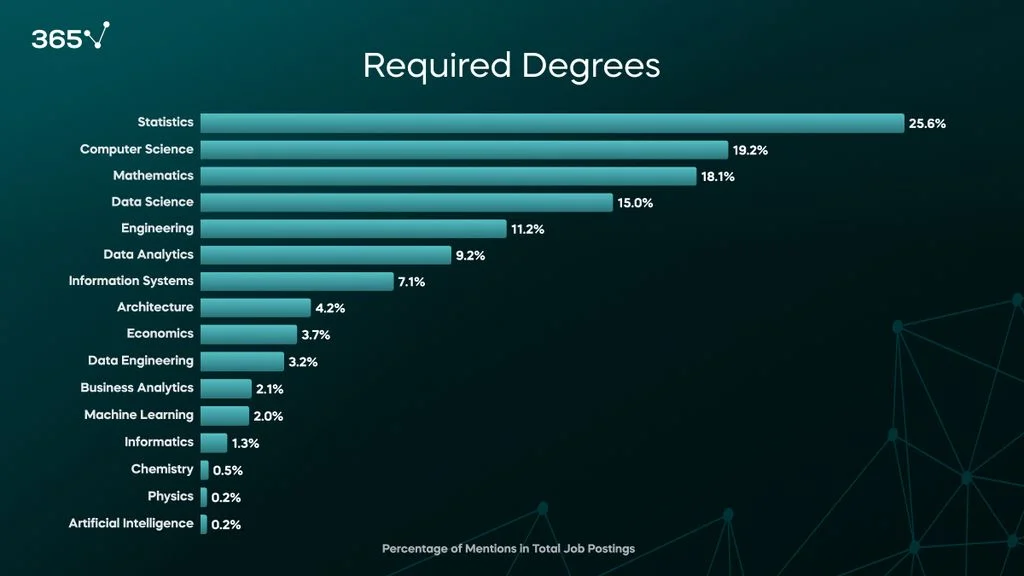
Not surprisingly, the most sought-after degree for data analyst roles is statistics—over a quarter of listings mention it as a prerequisite. Other frequently required degrees are computer science (19.2%), mathematics (19.2%) and data science (15.0%).
Interestingly, 11.2% of data analyst job postings mention an engineering degree, and 4.2% suggest an architecture degree. This implies that employers do not seek strictly traditional data analyst skills, but rather candidates whose proficiency in data analysis could evolve into a deeper understanding of data engineering or data architecture.
Put shortly, securing a data analyst job does not necessarily require a degree in statistics, computer science, or other fields commonly associated with the role. The diversity in educational backgrounds mentioned in job listings highlights that relevant skills often carry more weight.
Thanks to this, an aspiring data analyst can greatly benefit from pursuing online courses, bootcamps, or other alternative educational pathways. These resources provide the necessary skills and can be a pivotal step towards mastering data analysis, regardless of one’s formal academic background.But what about the general degree requirements? What does the data analyst job market specify regarding educational qualifications?
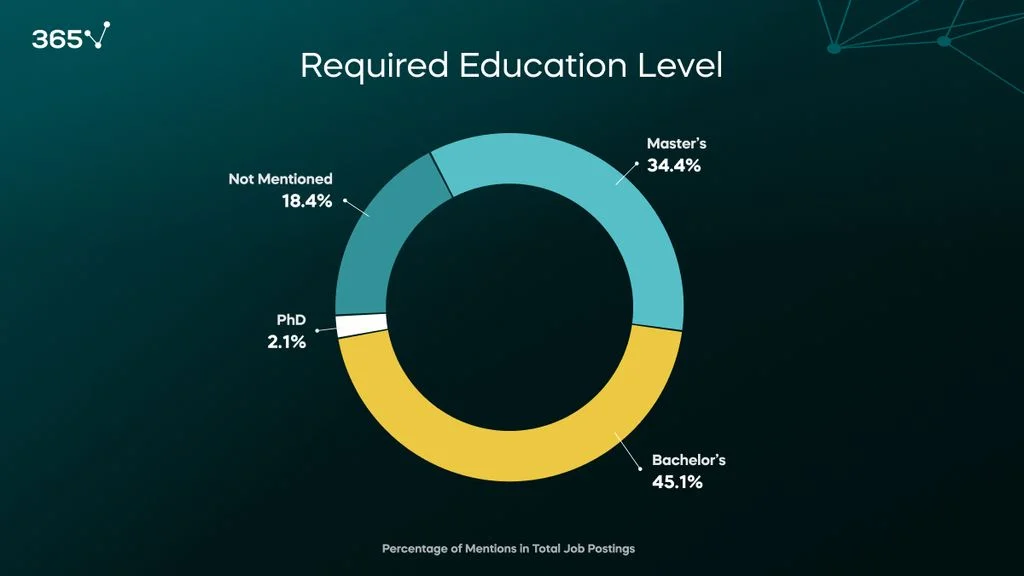
The data presents a varied picture. Approximately 45% of data analysis jobs require a bachelor’s degree, 34% seek candidates with a master's degree, while only 2% specify the need for a PhD.
Notably, 18.4% of the job postings do not mention any specific degree requirement. While this doesn't imply that these positions are exclusively for non-degree holders, it does indicate that individuals with a less traditional educational background can still be competitive candidates.
As mentioned earlier, the tech industry places a high value on skills, technical knowledge, and practical experience. As a result, if you are dedicated, have structured learning habits, and build a substantial projects portfolio, you can be competitive in the data analyst job market, regardless of your formal educational credentials.
The 365 Data Science platform is tailored to provide you with the extensive skills necessary for a prosperous career in data analytics. It also offers opportunities for practical projects, allowing you to showcase your abilities to potential employers. Whether you are just starting out or looking to enhance your data analyst skills, our platform supports your development in alignment with industry demands.
What Technical Skills Do You Need to Become a Data Analyst?
Data analysts require a robust set of technical skills, enabling them to effectively interpret and analyze data. Their goal is to ensure that insights are actionable for tasks like business intelligence, strategic planning, and predictive modeling.
Our research underscores a trend in the job market right now pushing for faster and more dynamic data analysis techniques in the industry. This development is consistent with the need for rapid, data-driven decision-making, emphasizing a demand for innovative analytical tools and methodologies.
Data Analysis Skills
Because the role involves a variety of tasks, the specific requirements for data analysis are diverse. These skills can be divided into several key categories:

Data Visualization
Data visualization is a key skill required for data analyst jobs, highlighted in 20.7% of postings. This role requires the ability to translate complex data findings into understandable graphical formats. Data visualization is crucial for effectively communicating insights using tools like Tableau or Power BI.
Statistical Analysis
Statistical analysis also forms a cornerstone of the data analyst's skill set, featuring in 11.9% of job ads. This skill is all about applying statistical techniques to decode and infer data, often calling for mastery of specific software, such as SAS or SPSS.
SAS, or Statistical Analysis System, is a key tool for data analysts, mentioned in 11.8% of listings. It is widely used for more intricate analytics, data management, and predictive modeling tasks.
SPSS, or the Statistical Package for the Social Sciences, is referenced in 3.7% of listings and is pivotal for carrying out a variety of statistical tests, particularly in social science research.
Data Mining
Data mining is mentioned in 9% of job postings, demonstrating the need for professionals who can sift through vast amounts of data to uncover patterns and relationships critical for informed business decisions.
Predictive Modeling
Predictive modeling is specified in 2.7% of job postings, indicating the value placed on the ability to use historical data to predict future trends.
Other Specific Skills
Approximately 5% of listings on the data analyst job market emphasize the need for specific analytical skills:
- Exploratory data analysis is noted in 1.8% of postings, serving as a fundamental step for identifying patterns and anomalies in data.
- Hypothesis testing, crucial for validating data assumptions, appears in 1.3% of postings.
- Regression analysis, key for mapping the relationship between variables, is mentioned in 0.8%.
- A/B testing, essential for comparative analytics to improve user experience, is sought in 0.7% of postings.
- Time series analysis, although only cited in 0.1% of postings, is pivotal for analyzing data points over time to forecast trends and inform strategic planning.
Data Visualization Skills
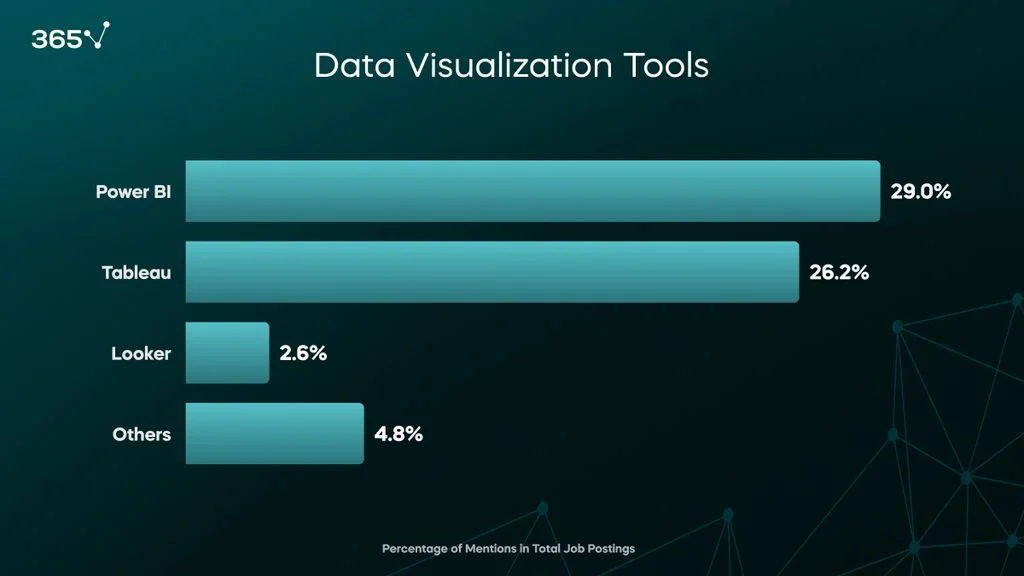
In a closer look at the specific data visualization tools mentioned in data analyst job postings, we observe a clear preference:
Power BI leads the pack, mentioned in 29% of job postings. This software is favored for its integration capabilities and user-friendly interface.
Tableau is close behind, noted in 26.2% of postings. It’s renowned for its powerful data visualization capabilities that transform complex data sets into actionable insights.
Looker, also part of the toolkit for some data analysts, appears in 2.6% of job listings. This tool is valued for its business intelligence functionalities and real-time data access.
Other tools collectively represent 4.8%, indicating a smaller but varied demand for additional data visualization software in the field.
Programming Skills
A data analyst job is very likely to require some programming skills. Our research reveals a distinct preference in the data analyst job market:
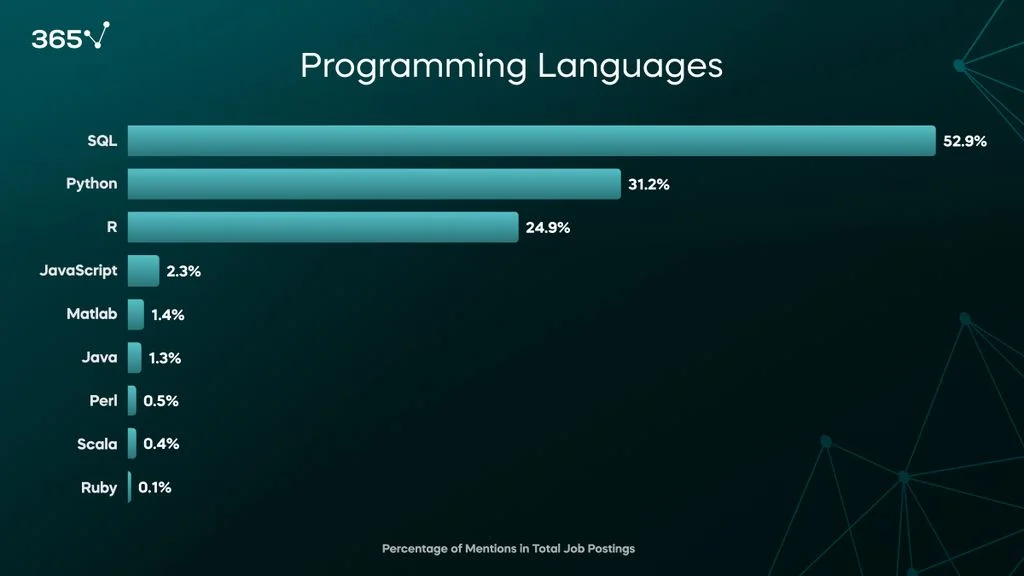
SQL leads, noted in 52.9% of postings for data analyst roles. This language is critical for its versatility in data manipulation and retrieval tasks.
Python appears in 31.2% of job postings, standing out among the most required programming languages for a data analyst, recognized for its key role in data analysis and machine learning applications.
R, which is frequently used for its statistical analysis capabilities, is also significant, mentioned in a quarter of the listings. Less common but still relevant are languages such as JavaScript (2.3%) and MATLAB (1.4%), each recognized for their specific applications in data processing and statistical analysis.
Other languages like Java, Perl, Scala, and Ruby are mentioned in 1.3%, 0.5%, 0.4%, and 0.1% of postings respectively, indicating their niche roles in data analytics jobs.
AI and Machine Learning Skills
In the era of rapidly developing AI, data analysts are increasingly required to have some range of AI skills. These skills are pivotal for navigating the complex landscape of modern data environments.
The increasing demand for AI capabilities suggests that data analysts should become more versatile and not restrict themselves to narrowly defined tasks in the near future.
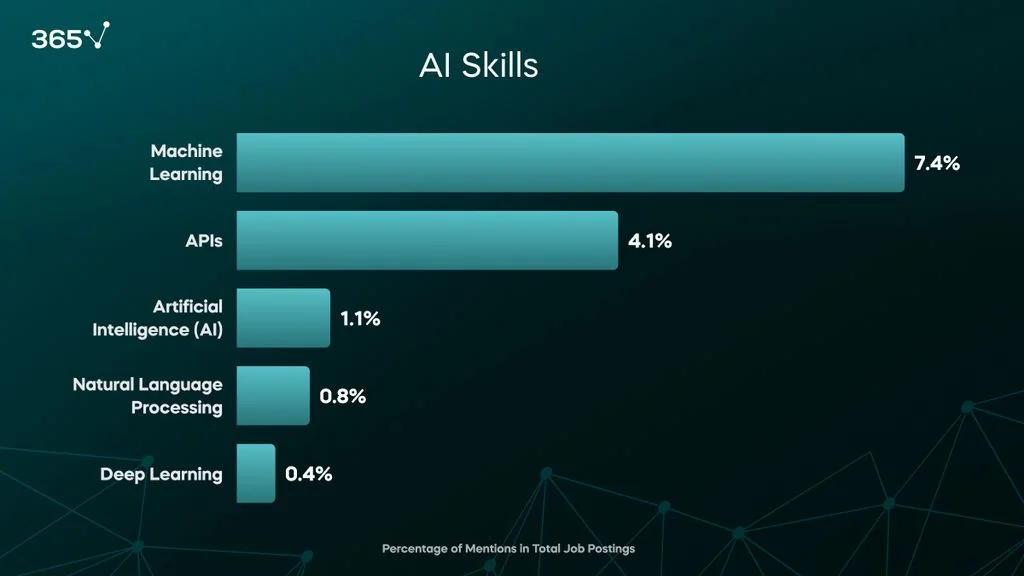
Machine learning emerges as the most sought-after AI skill on the data analyst job market, noted in 7.4% of job postings. This indicates a strong demand for professionals capable of developing and applying machine learning models.
APIs, which play a critical role in integrating different software components, are also significant, appearing in 4.1% of postings.
Other mentions in data analyst job postings include artificial intelligence (1.1%) and natural language processing (0.8%), reflecting their growing but niche application in the field. Deep learning, though less commonly required at 0.4%, is still noted for its importance in more advanced AI tasks.
A detailed examination of machine learning techniques required for data analysts highlights a range of specialized skills:
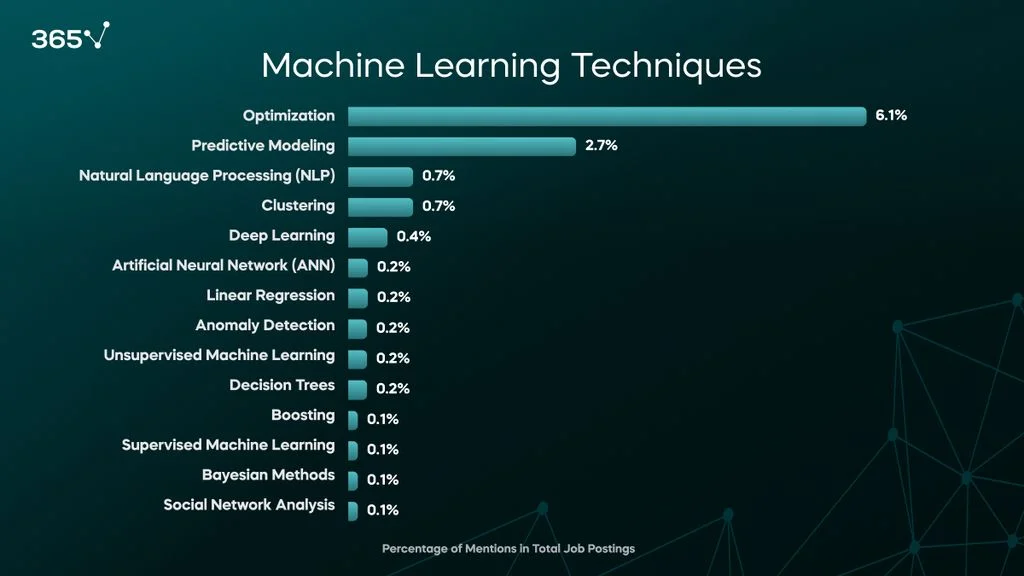
Optimization, mentioned in 6.1% of job listings, is at the forefront, emphasizing its critical role in refining algorithms and improving outcomes.
Predictive modeling, present in 2.7% of postings, follows, illustrating its significance in forecasting and decision-making processes.
Other important techniques include natural language processing and clustering, each cited in 0.7% of postings. These skills essential for analyzing text data and segmenting datasets, respectively.
Although they are only mentioned in very few job postings, techniques such as deep learning, regression analysis, and anomaly detection, underscore the need for a broad and advanced skill set in more targeted areas of machine learning.
This spectrum of machine learning techniques sought-after in data analyst job listings reflects the evolving complexity and specialization in data analytics technologies.
Cloud Skills
Shifting focus to cloud technologies, it’s evident that cloud skills are also becoming increasingly important for a data analyst.
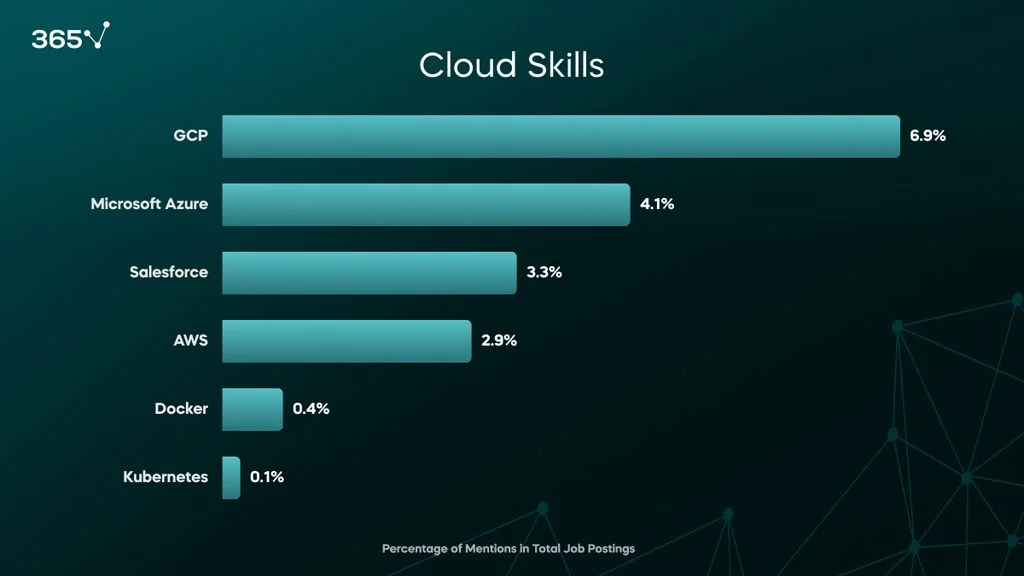
Google Cloud Platform (GCP), appearing in 6.9% of data analyst job postings, leads the demand as it offers robust, scalable cloud computing solutions.
Microsoft Azure, cited in 4.1% of postings, follows, known for its enterprise-grade cloud services.
Salesforce, not traditionally known for heavy computing, is noted by 3.3% of employers, likely for its cloud-based CRM capabilities.
Amazon Web Services (AWS), appearing in 2.9% of listings, is another major player, highlighting its essential role in cloud infrastructure services.
Lesser-known tools like Docker and Kubernetes also appear, in 0.4% and 0.1% of postings respectively, pointing to their specialized use in containerization and orchestration within cloud environments.
Office Tools
Turning our attention to proficiency in more traditional but essential Microsoft Office Tools, it's not a surprise that Excel dominates as a critical skill among data analyst requirements.
Among postings that require MS Office, Excel is mentioned in half of them (50.5%). The high demand highlights Excel's paramount role in data management and analysis, serving as a primary tool for tasks ranging from simple data entry to complex statistical analysis and visualization.
Other Office tools also play significant roles, with Word required for documentation (in 13.6% of listings mentioning MS Office) and PowerPoint for presentations (13.2%).
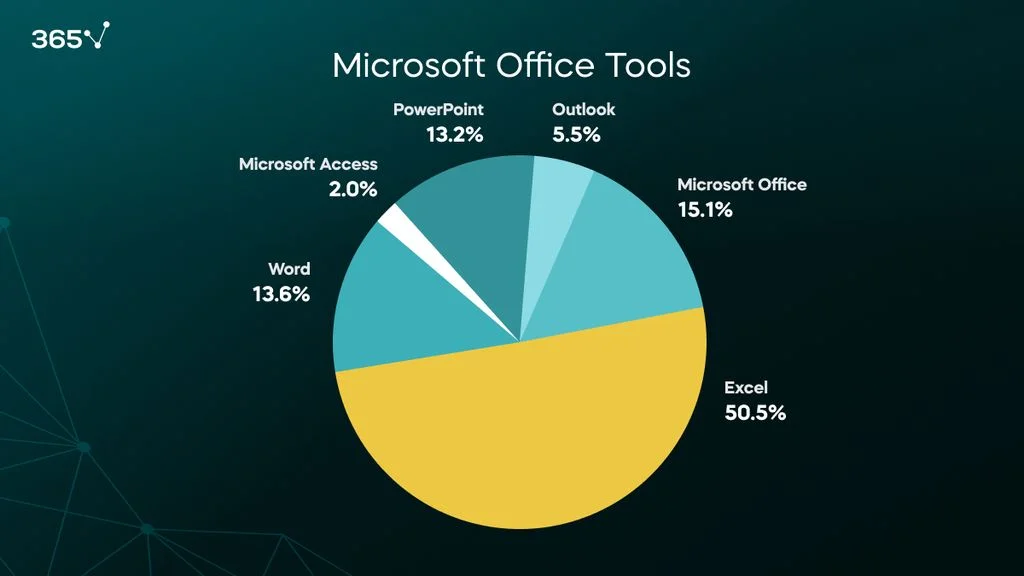
| Number of postings | |
| Excel | 375 |
| Microsoft Office | 112 |
| Word | 101 |
| PowerPoint | 98 |
| Outlook | 41 |
| Microsoft Access | 15 |
Data Engineering Skills
Data engineer and data analyst roles, while interconnected, focus on distinct aspects of data management.
A data analyst primarily interprets and derives insights from data, utilizing engineering skills to manipulate and process data efficiently. On the other hand, a data engineer concentrates on building and maintaining robust data infrastructure that supports such analysis.
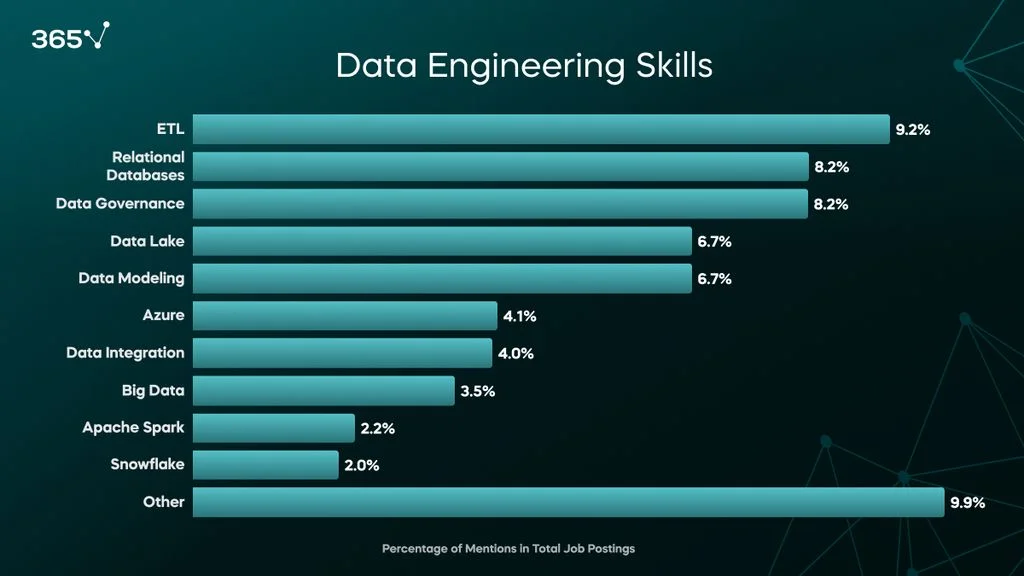
The two roles can somewhat overlap, as they demand a broad skill set. The presence of data engineering skills in job postings for data analysts supports this. Multifaceted professionals are increasingly sought after, particularly in smaller companies, where there is a growing need for individuals capable of managing all aspects of the data lifecycle—from collection and analysis to interpretation and implementation.
According to our data analyst job market research, ETL skills (Extract, Transform, Load) stand out, cited in 9.2% of postings, highlighting their critical role in preparing data for analysis.
Relational databases appear in 8.2% of postings, tied with data governance. They are essential for querying and managing structured data, which ensures data accuracy and compliance.
Skills in managing data lakes and performing data modeling are also commonly expected in a data analyst’s skill set, each mentioned in 6.7% of postings. These skills are vital for storing unstructured data and creating interpretable data frameworks, respectively.
Microsoft Azure, noted in 4.1% of postings, reflects the importance of cloud platforms in handling and processing large data sets.
Additionally, data integration and big data skills appear in 4.0% and 3.5% of data analyst positions, respectively. These skills underline the need for synthesizing diverse data sources and handling extensive datasets effectively.
Specialized tools like Apache Spark and Snowflake, although less frequently mentioned at 2.2% and 2.0%, are important for their powerful data processing and storage capabilities.
These diverse data engineering skills are important data analyst requirements for candidates to be able to efficiently access, process, and analyze large datasets in today’s complex data environments.
Data Architecture Skills
Data architecture skills are also important for data analyst positions, required to design and structure data systems effectively.
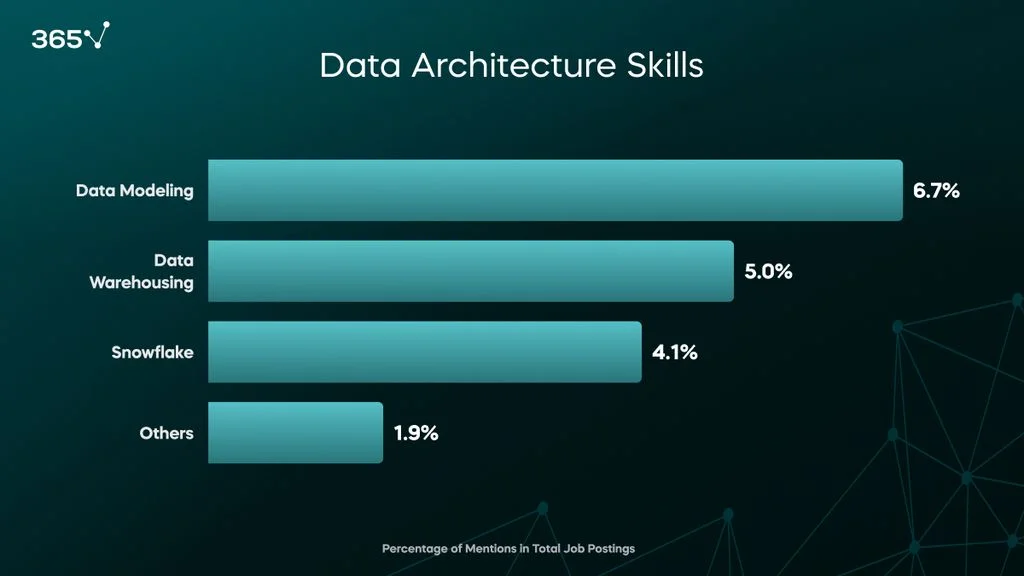
Data modeling, mentioned in 6.7% of postings, leads in demand, highlighting its critical role in creating conceptual models for complex data environments.
Data warehousing follows, featured in 5.0% of job listings, emphasizing the need for skills in managing and maintaining large repositories of structured data for better accessibility and analysis.
Snowflake, a cloud-based data warehousing service, is specifically noted by 4.1% of employers, indicating a preference for modern, scalable cloud storage solutions that support data-driven decision-making.
These skills collectively ensure that data analysts can effectively manage, structure, and utilize data to meet organizational needs.
Where Do Data Analysts Work?
The 855 data analyst job postings originate from 36 US states and 477 unique companies.
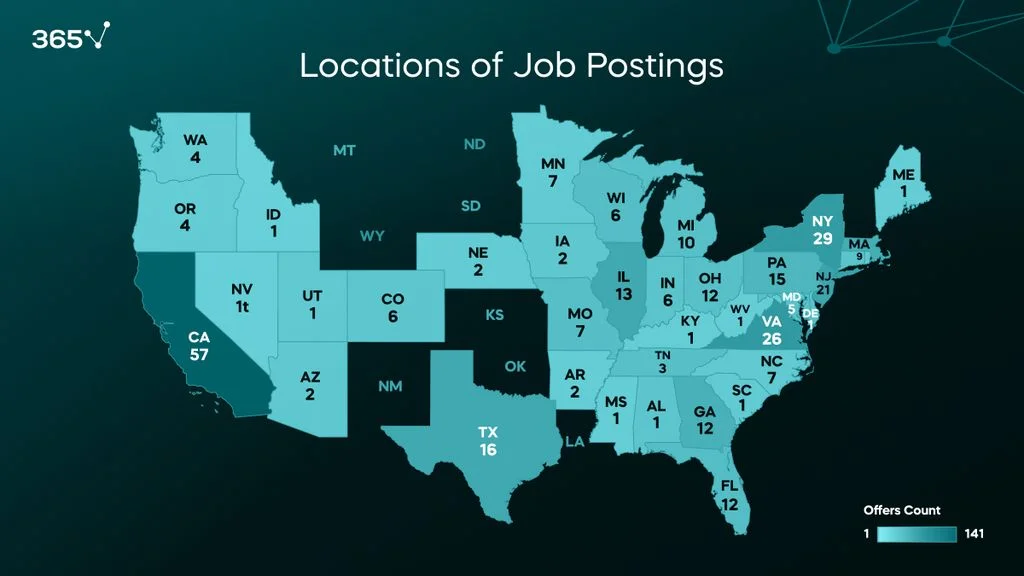
The top 10 states leading in data analyst job offerings are as follows:
- California
- New York
- Virginia
- New Jersey
- Texas
- Pennsylvania
- Illinois
- Florida
- Georgia
- Ohio
Our research on the data analyst job market this year reveals that only 2.81% of job postings explicitly mention a remote location. This low percentage suggests that the Covid-induced trend towards home office work is phasing out, leading to a resurgence of onsite or hybrid work options for data analysts. This shift indicates that, despite the broader movement towards remote work in various sectors in the last few years, data analyst roles are increasingly returning to traditional or hybrid work environments in 2024.
Many businesses may prefer or require data analysts to be present in a physical office, possibly due to the collaborative nature of the work or the sensitive nature of the data handled.
As the data analyst job market continues to evolve, it will be interesting to see if this trend continues, and to what extent data analysts will be able to benefit from the flexibility of remote work.
How Much Do Data Analysts Make?
According to Glassdoor, the total average salary for a data analyst in the US for 2024 is \$90,628 annually, with a range between \$56,000 and \$149,000. Our research supports this, with the most frequently mentioned salaries falling between \$60,000 and \$100,000. Interestingly, nearly a third of the job postings openly listed the expected salary range.
You may also be curious about the average entry-level data analyst salary. Below are Glassdoor's estimates of the median total annual pay for a data analyst role in 2024, broken down by experience level.
- 0-1 Years: \$61K - \$101K/yr
- 1-3 Years: \$67K - \$111K/yr
- 4-6 Years: \$70K - \$124K/yr
- 7-9 Years: \$73K - \$127K/yr
- 10-14 Years: \$78K - \$137K/yr
- 15+ Years: \$87K - \$156K/yr
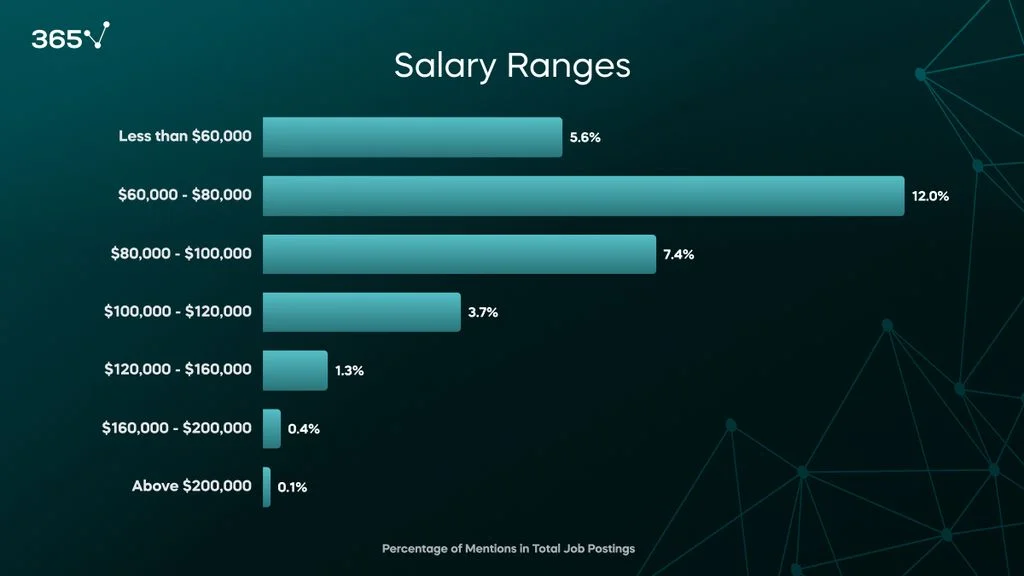
The data analyst salary ranges in the job listings we analyzed vary significantly. This variation reflects differences in experience, industry, and geographic location.
According to our research, the most common data analyst salary range is between \$60,000 and \$80,000, accounting for 12.0% of postings—suggesting that many positions offer competitive mid-level salaries.
Salaries ranging from \$80,000 to \$100,000, noted in 7.4% of postings, are also fairly common, indicating opportunities for more experienced analysts or those in specialized sectors. For those with advanced skills or in high-demand areas, the salary can range from \$100,000 to \$120,000, as seen in 3.7% of job postings.
Higher salaries, reaching up to \$200,000, are less common but still available. These figures are typically associated with senior data analyst roles or positions within high-paying industries.
It's essential to remember that this information is specifically related to the data analyst job outlook in the US. Additionally, salaries can be influenced by various factors such as company size, industry sector, and location.
Overall, the results from our data analyst job market research show that a data analyst career has substantial potential for competitive remuneration, particularly with experience and specialization in areas with high data analyst demand.
Required Experience
In terms of experience, employers predominantly seek individuals with mid-level experience, as evidenced by the higher demand for candidates with 2–4 years in the field (accounting for 6.4% of job postings).
This suggests a focus on applicants with practical competence and well-developed skills and knowledge.
Those with 0–2 years of experience are also in significant demand, featured in 5.1% of job postings, indicating that the data analyst job market is promising for entry-level positions as well.
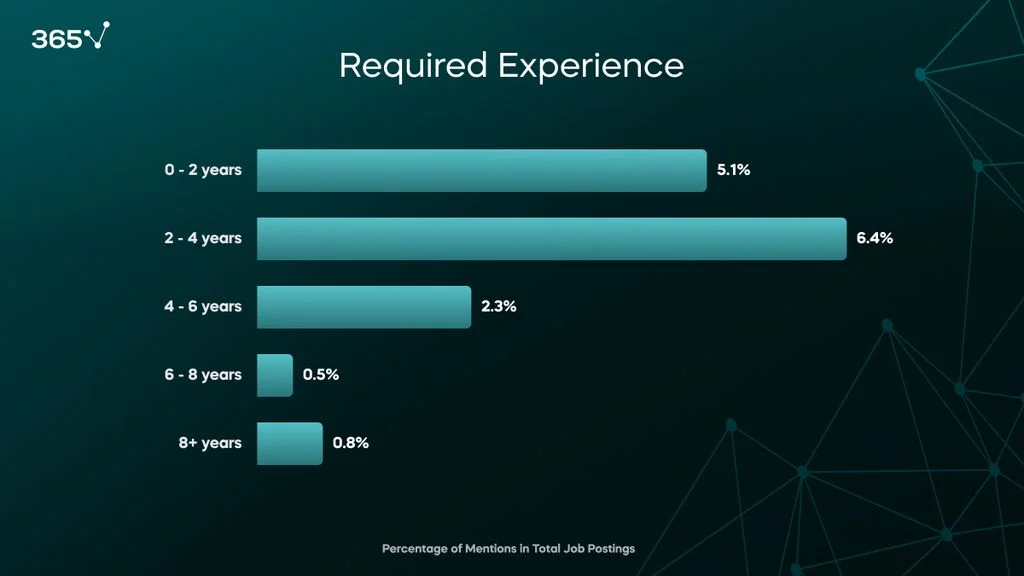
Interestingly, nearly 85% of the listings for data analyst jobs that we analyzed do not specify any required experience. This significant omission suggests a flexible job market where employers are prioritizing skills and capabilities over years of experience.
This trend provides an encouraging environment for both newcomers and seasoned professionals. It allows them to leverage their demonstrable skills to secure positions in the field of data analysis, making the field accessible to a wide range of professionals at various stages of their careers.
What Is the Data Analyst Job Outlook in 2024?
You might be wondering: are data analysts in demand in 2024?
Over recent years, the role of data in strategic decision-making has escalated, with each data set offering critical insights that drive business strategies.
The surge in big data usage has intensified the need for skilled professionals who can extract meaningful insights from complex datasets and inform decision-making across various sectors, boosting the data analyst demand.
With a growing emphasis on data-driven decisions, there is a particular need for expertise in analytics tools and platforms such as Python, SQL, and data visualization software like Tableau and Power BI. The data analyst job outlook in 2024 is robust, reflecting the vital role of this position in leveraging data for competitive advantage.
The US Bureau of Labor Statistics reports that the employment of data scientists is projected to increase by 36% from 2021 to 2031, of statisticians – by 31%, and of market research analysts – by 19%. These growth rates surpass the average across all occupations (5%), positioning data analysis and other data-centric fields among the fastest-growing careers currently.
The escalating data analyst salary further highlights the significance of these roles within the tech industry. In 2023, the average salary for data analyst positions was \$70,365/year. By 2024, this figure has risen to \$90,628, marking a substantial increase of over \$20,000 in just one year. Considering these job market trends, the future of data analytics looks promising.
Starting a Data Analytics Career
The data analyst job market is a dynamic and evolving field, increasingly central to an organization's ability to leverage data effectively. This role is becoming ever more critical as companies intensify their focus on data-driven decision-making—making the data analyst career path more and more exciting.
Essential data analyst skills include advanced statistical analysis, data visualization, programming languages like SQL and Python, and proficiency with analytics tools such as Tableau or Power BI.
While these competencies are anchored in the world of data analysis, there is also a significant crossover with skills from data engineering and data science, highlighting the interconnected nature of these areas and the demand for versatile skill sets in the data analyst job market.
While degrees in fields such as statistics or data science are highly regarded, the tech industry is increasingly receptive to candidates from less conventional backgrounds, prioritizing practical skills and experience over traditional academic credentials—paving the way for diverse pathways for careers in data analytics.
Our research has shown that career prospects for data analysts continue to be very promising in the job market right now, highlighting the increasing acknowledgment of the crucial role they fulfill in today's data-driven world.
Aspiring data analysts should aim to broaden their skill set, stay updated with all the latest technologies, and showcase their practical abilities. A good starting point is to identify the best resources available.
The 365 Data Science platform offers a wide range of courses, covering essential skills like SQL, Python, Excel, Tableau, Power BI, and much more. Additionally, we provide practical projects that allow you to showcase your capabilities to prospective employers on the data analyst job market.
Regardless of your initial skill level, adopting a continuous learning mindset is crucial for distinguishing yourself in the competitive field of data analysis.

![The Data Scientist Job Market in 2024 [Research on 1,000 Job Postings]](https://365datascience.com/resources/blog/thumb@360_gex3csy60x9-03-data-scientist-jobs-research-blog-thumbnail-2.webp)

![The Data Engineer Job Market in 2024 [Research on 1,000 Job Postings]](https://365datascience.com/resources/blog/thumb@360_dchpoi3t20s-thumb01.webp)

![Data Analyst Job Outlook 2025 [Research on 1,000 Job Postings]](https://365datascience.com/resources/blog/thumb@360_ciqytcbcw5e-the-data-engineer-job-market-thumb-1.webp)
